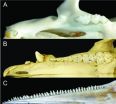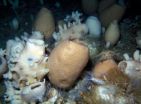(Press-News.org) Charlottesville, VA, February 19, 2013. Neurosurgeons from UC San Francisco describe the use of 5-aminolevulinic acid (5-ALA) fluorescence in guiding resection of recurrent glioblastoma multiforme (GBM). Ingestion of 5-ALA by a patient before surgery leads to fluorescence of tumor cells intraoperatively in response to certain wavelengths of light. This can provide information not necessarily available through magnetic resonance imaging (MRI), the standard mode of imaging used to detect primary and recurrent GBMs. The additional information provided by 5-ALA fluorescence can guide surgeons in the treatment of individual cases.
The case of a 56-year-old man is described in the article "Subependymal spread of recurrent glioblastoma detected with the intraoperative use of 5-aminolevulinic acid. Case report," by Tene A. Cage, M.D., Melike Pekmezci, M.D., Michael Prados, M.D., and Mitchel S. Berger, M.D., published today online, ahead of print, in the Journal of Neurosurgery. The patient presented with frequent transient visual disturbances. Seven years earlier, he had undergone gross-total (maximum) resection of a GBM located in the right occipital lobe. A new MRI study was performed and the images showed three distinct, new sites of tumor in the man's right temporal lobe. There was no evidence of recurrent tumor at the site where the original tumor had been located.
Glioblastoma multiforme (GBM) is the most common primary tumor of the brain. It is extremely aggressive and is usually treated with resection followed by chemotherapy and radiotherapy. Even using this treatment, patient survival is not long: on average 1 to 2 years. The authors note that the best way to lengthen survival is to remove as much tumor as possible. This holds for recurrent GBM as well as for the initial tumor.
The patient in this case was scheduled for surgery to remove the three new lesions. To aid in visualization of the lesions intraoperatively, the neurosurgical team, led by Mitchel S. Berger, M.D., Chairman of the Department of Neurological Surgery at UC San Francisco, administered 5-ALA to the patient four hours prior to surgery. During surgery, a blue light was used to activate 5-ALA fluorescence of tumor cells and thus differentiate tumor from other brain tissue. Using the blue light, the surgeons were able to detect tumor cells along the lining of the right lateral ventricle, in the ependymal and subependymal regions. Although the appearance of the three lesions on preoperative MRI had indicated distinct sites of recurrent disease (multicentric tumor recurrence), the fluorescence of tumor cells during surgery mapped out the spread of disease from the original GBM site in the right occipital lobe to three sites in the right temporal lobe through a pathway along the wall of the right ventricle. This showed that the GBM recurrence was not multicentric at all. The fluorescence also made it possible for the surgeons to identify and resect additional tumor tissue along the pathway between the original and recurrent lesions.
According to the authors, MRI is unable to clearly delineate diffuse tumor infiltrating the ependyma and subependymal zone lining the lateral ventricle. Addition of 5-ALA fluorescence during surgery revealed the pathway of tumor spread through these regions.
With recurrent GBM, it is valuable to distinguish whether the recurrence is multicentric disease or infiltrative disease extending from the original tumor. According to Dr. Berger, "Multicentric disease can add a worse prognosis. Finding it during surgery is important and can influence the extent of resection." Addition of 5-ALA fluorescence has been identified as substantially increasing the success of achieving maximum resection. Dr. Berger says that intraoperative use of 5-ALA "could be useful in all GBM cases."
###
Cage TA, Pekmezci M, Prados M, Berger MS. Subependymal spread of recurrent glioblastoma detected with the intraoperative use of 5-aminolevulinic acid. Case report. Journal of Neurosurgery, published online, ahead of print, on February 19, 2013 (DOI: 10.3171/2013.1.JNS121537).
Disclosure: The authors report no conflict of interest concerning the materials or methods used in this study or the findings specified in this paper.
For additional information, please contact:
Ms. Jo Ann M. Eliason, Communications Manager
Journal of Neurosurgery Publishing Group
One Morton Drive, Suite 200
Charlottesville, Virginia 22903
Email: jaeliason@thejns.org
Telephone 434-982-1209; Fax 434-924-2702
For 68 years, the Journal of Neurosurgery has been recognized by neurosurgeons and other medical specialists the world over for its authoritative clinical articles, cutting-edge laboratory research papers, renowned case reports, expert technical notes, and more. Each article is rigorously peer reviewed. The Journal of Neurosurgery is published monthly by the JNS Publishing Group, the scholarly journal division of the American Association of Neurological Surgeons, an association dedicated to advancing the specialty of neurological surgery in order to promote the highest quality of patient care. The Journal of Neurosurgery appears in print and on the Internet.
5-ALA fluorescence guides resection of recurrent glioblastoma multiforme
2013-02-19
ELSE PRESS RELEASES FROM THIS DATE:
How the whale got its teeth
2013-02-19
Whales are mammals, but they don't look like the mammals living around us, as they have a triangular fluke for tail, no hind legs and no body hair. And inside their mouths, their teeth are unfamiliar too – being much simpler and 'peg like'. A multidisciplinary team of researchers have now married together the fossil record and the embryonic development process to investigate how the whale got its teeth.
Most mammals have four kinds of teeth, each shaped for specific tasks. In most mammals there are wedge-shaped incisors, a pointy canine, and premolars and molars with ...
Stillbirth in Inuit and First Nations women higher than for non-Aboriginal residents
2013-02-19
Stillbirth rates in First Nations and Inuit populations in Quebec are higher than in the general population, especially in late gestation and at term, found a new study in CMAJ (Canadian Medical Association Journal).
"Aboriginal populations in Canada [First Nations and Inuit] rank at the top of the list of disadvantaged groups with the highest rates of stillbirth in the Western world," writes Dr. Nathalie Auger, Institut national de santé publique du Québec, with coauthors. Rates are 2 times those of the non-Aboriginal population.
Researchers looked at data on 9983 ...
Unplanned hospitalization more likely in people with several illnesses, mental health conditions
2013-02-19
People with multiple illnesses are much more likely to be admitted to hospital unexpectedly, and mental health issues and economic hardship further increase the likelihood, according to a study in CMAJ (Canadian Medical Association Journal).
"We provide strong evidence that physical multimorbidity substantially affects the use of acute hospital services, including admissions considered potentially preventable through management of optimal primary care," writes Dr. Rupert Payne, Cambridge Centre for Health Services Research, University of Cambridge, Cambridge, United Kingdom. ...
There's room for improvement in women's heart disease awareness
2013-02-19
The number of women aware that heart disease is the leading cause of death has nearly doubled in the last 15 years, but that knowledge still lags in minorities and younger women, according to a new study in the American Heart Association journal Circulation.
Researchers comparing women's views about heart disease in 1997 and today, found:
In 2012, 56 percent of women identified heart disease as the leading cause of death compared with 30 percent in 1997.
In 1997, women were more likely to cite cancer than heart disease as the leading killer (35 percent versus 30 ...
Data paper describes Antarctic biodiversity data gathered by 90 expeditions since 1956
2013-02-19
A new peer-reviewed data paper offers a comprehensive, open-access collection of georeferenced biological information about the Antarctic macrobenthic communities. The term macrobenthic refers to the visible-for-the-eye organisms that live near or on the sea bottom such as echinoderms, sponges, ascidians, crustaceans. The paper will help in coordinating biodiversity research and conservation activities on species living near the ocean bottom of the Antarctic.
The data paper "Antarctic macrobenthic communities: A compilation of circumpolar information", published in the ...
Phosphorus starvation linked to symptoms of citrus disease Huanglongbing in new study
2013-02-19
The citrus disease Huanglongbing (HLB), meaning "yellow shoot disease" in Chinese and also called citrus greening in English-speaking countries, is the most destructive disease threatening the citrus industry worldwide. Powerful diagnostic tools and management strategies are desired to control it. A new study, 'Small RNA profiling reveals phosphorus deficiency as a contributing factor in symptom expression for citrus Huanglongbing disease', published online today (Friday) in the journal Molecular Plant profiled small Ribonucleic Acids (sRNAs) from both diseased and healthy ...
Moffitt researchers say silencing of retinoblastoma gene regulates differentiation of myeloid cells
2013-02-19
Researchers at the Moffitt Cancer Center have found a potential mechanism by which immune suppressive myeloid-derived suppressor cells can prevent immune response from developing in cancer. This mechanism includes silencing the tumor suppressor gene retinoblastoma 1 or Rb1. Their data explains a new regulatory mechanism by which myeloid-derived suppressor cells are expanded in cancer.
Their study appeared in a recent issue of Nature Immunology.
According to the authors, two kinds of myeloid-derived suppressor cells - monocytic M-MDSCs and granulocytic PMN-MDSCs - regulate ...
New scorpion discovery near metropolitan Tucson, Arizona
2013-02-19
A new species of scorpion, Vaejovis brysoni, was found in the Santa Catalina Mountains in southern Arizona. Another scorpion of the same group also inhabits this mountain range, making this the first documented case of two vorhiesi group species distributed on the same mountain. The study was published in the open access, peer-reviewed journal Zookeys.
These mountains overlook the city of Tucson, Arizona. Amazingly, in the 21st century, there are still new species to be discovered right here in the United States. What is even more surprising is that the new species was ...
Using mouthrinse reduces plaque and gingivitis more than toothbrushing alone
2013-02-19
CHICAGO (Feb. 19, 2013)—New research published in the January/February 2013 issue of General Dentistry, the peer-reviewed clinical journal of the Academy of General Dentistry (AGD), indicates that the use of a germ-killing mouthrinse in addition to regular toothbrushing can significantly reduce plaque and gingivitis, more so than brushing alone.
"It's simple—mouthrinses can reach nearly 100 percent of the mouth's surfaces, while brushing focuses on the teeth, which make up only 25 percent of the mouth," says Christine A. Charles, RDH, BS, lead author of the study and ...
Genetic signs of alcoholism in women studied for the first time
2013-02-19
This press release is available in Spanish.
Research done at the UPV/EHU-University of the Basque Country has determined the frequency of genetic variants linked to alcoholism for the Spanish population, and its incidence not only in individuals with a high level of alcohol intake, but also in individuals with alcohol dependence. Furthermore, the broad presence of women in the sample has made it possible, for the first time, to associate some of these genetic variants with a high level of alcohol intake in women. The results have been published in various top, international ...



